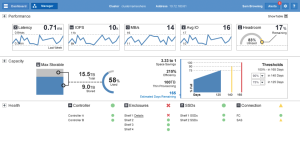

View Case Study
EchoUser helped NetApp create a user experience representative of its new enterprise storage tool.
Enterprise technology is typically known for its innovation in features capability, not user experience. NetApp tapped EchoUser to help the company change the pillars of enterprise product design and create a user experience that fully represents the leap in technology and performance that the underlying product represents -- making users immediately understand that they were dealing with something new, better and faster. EchoUser accomplished this by relying on its four fundamental principles of research and design: 1) Focus on real end-users; 2) Validate requirements and designs; 3) Design, prototype and develop iteratively; and 4) Understand and design for the holistic user experience. EchoUser kicked-off the project by helping NetApp define an overall guiding principle to serve as a single unifying philosophy for the design of the FlashRay product user experience. The company then embarked on an extensive end-user research project to better understand exactly how customers worked with current systems. This included contextual interviews and watching users interact with the product in server rooms to identify pain points, processes for new product evaluations and general practices and procedures. EchoUser used the research to develop a persona of the FlashRay user, which helped them better understand who they were building for and the world in which they worked. EchoUser conducted cognitive walkthroughs on the Installer, Dashboard and Manager areas to get real-time feedback during the design process and used the findings from these usability tests to tweak designs and continue increasing the fidelity and breadth of the design work. One of the most important results of the research was the development of use cases and user stories. These were key drivers in the design of the user experience. The use cases and user stories were a direct result of EchoUser’s interviews with NetApp end users, cognitive walkthroughs, design drafts and the updated personas. With this information, the design team came up with conceptual designs, working directly with internal NetApp subject matter experts to make sure they were correctly interpreting system requirements and domain. They also worked closely with the NetApp development team to make sure they were designing things they could build and that they fully understood the intent and direction. In the end, EchoUser helped NetApp create a modern user experience that is simple, easy-to-use, and clearly communicates the huge performance advantages of the FlashRay product. In parallel, EchoUser developed new visual design/branding. The final visual design was modern, professional and cool. The design techniques that applied included maximizing white space, using clean lines and angles, and applying a generally simple style that comes from the minimal use of textures and effects and a restrained color palette.
- Live Project Link: https://www.youtube.com/watch?v=2R1ZZXXEBMg&feature=youtu.be
- Why this project is worthy of a UX Award:
EchoUser brought a true user-centered design approach to the project. They incorporated actual user research and usability evaluation into the design process, as well as helped NetApp articulate its goals to create a set of design philosophies. EchoUser’s user-centered design approach is both a philosophy and a set of methods that focuses on designing for and involving the end-user in application development to achieve high-quality user experiences and high-quality products. This represents a fundamental shift that has been happening in the enterprise space where products are now being designed with the user experience as a priority. It also brings a different measuring stick to these types of products, one that all user experiences should be measured against. NetApp’s own directive to minimize the time of installation to an actual running system (aka, the time to “customer delight,”) empowered EchoUser to ruthlessly streamline the UI design. In addition, recognizing that FlashRay represented a fundamental improvement in storage robustness and reliability, EchoUser was able to optimize the UI to present more valuable and informative performance information. This better matched the workflow of storage administrators - identifying the problem in a performance context and then diving into the actual root cause of that problem. At a process level, EchoUser’s ability to evaluate and iterate prototype designs parallel to NetApp’s development effort, gave NetApp a substantial head start for their external beta test and first product release.
- Submitted By: EchoUser
- Client Name: NetApp
See More 2014 Submissions >>